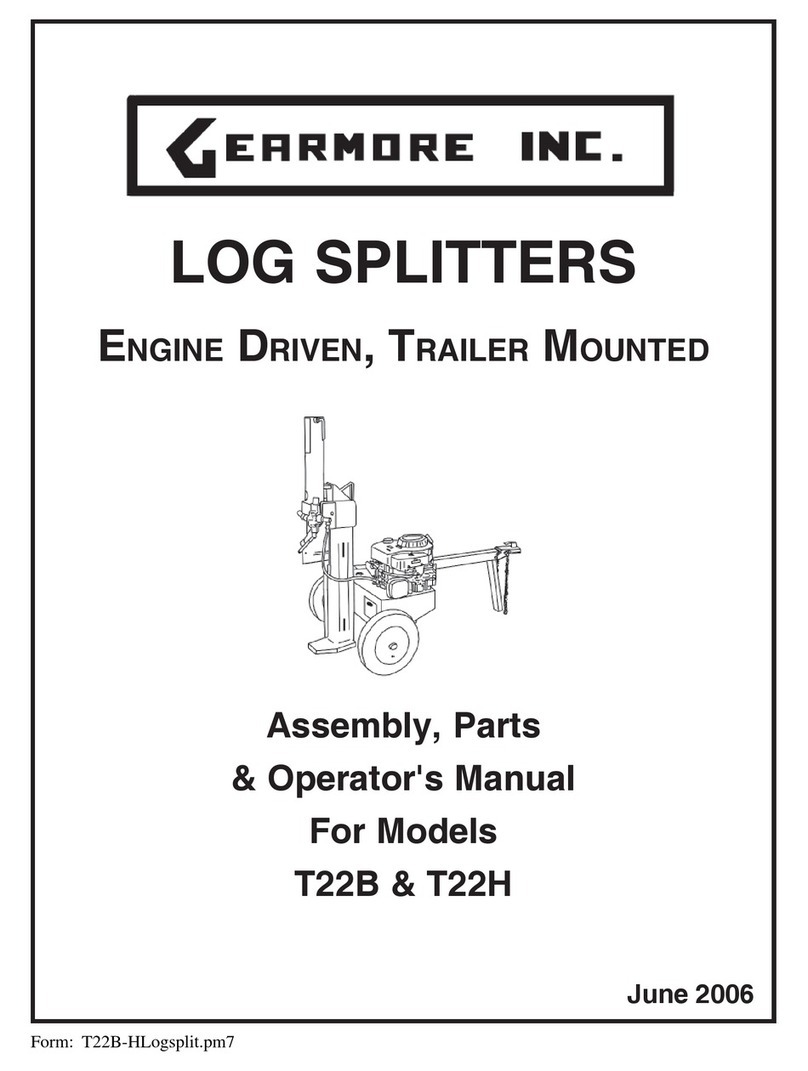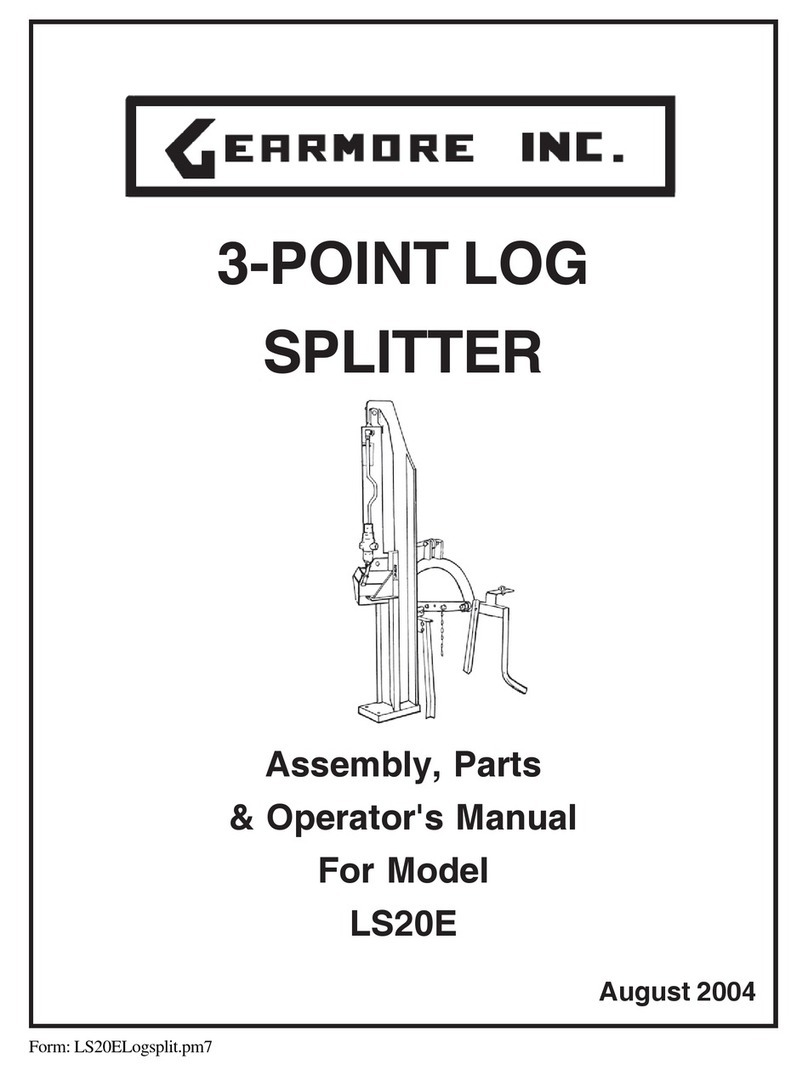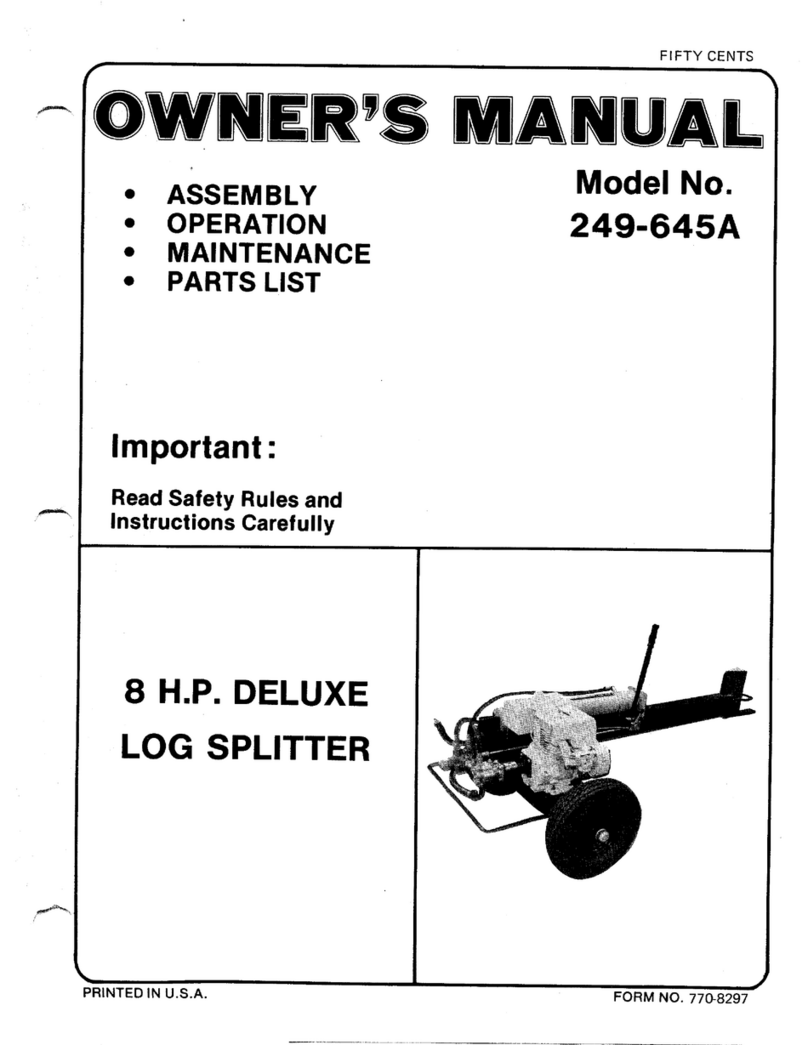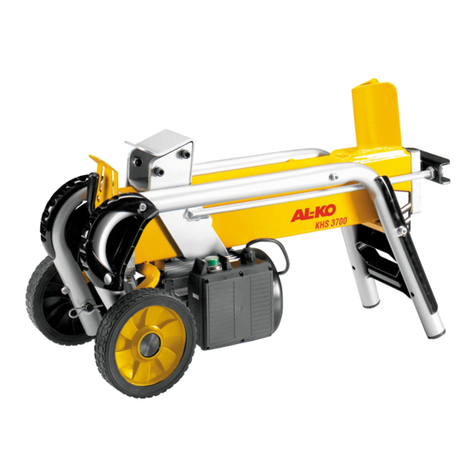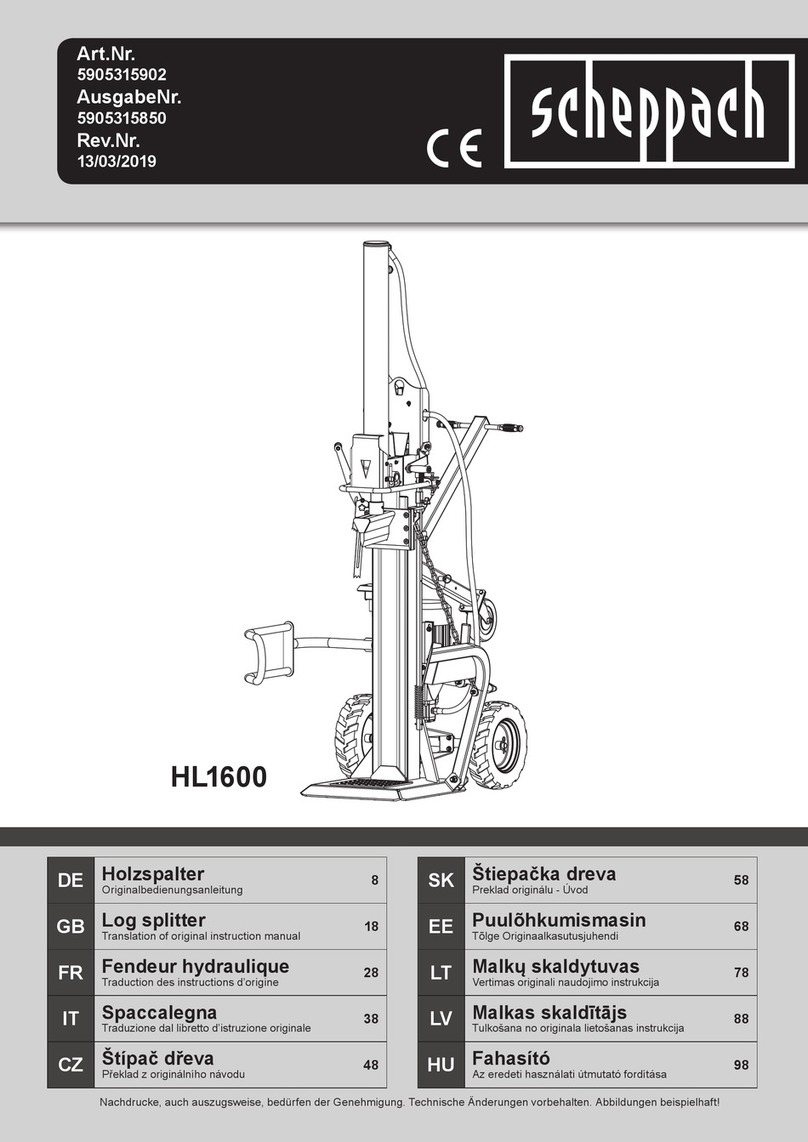Gearmore T34B Datasheet

LOG SPLITTERS
ENGINE DRIVEN, TRAILER MOUNTED
Assembly, Parts
& Operator's Manual
For Model
T34B
March 2007
Form: T34BLogsplit.pm7

TABLE OF CONTENTS
SECTION DESCRIPTION
PAGE
1 Introduction .............................................................. 1
1.1 Specifications .......................................................... 1
2 Safety .......................................................................... 2
2.1 Training & Preparation .......................................... 3
2.2 Safety Wear ............................................................. 3
2.3 Operating Safety ..................................................... 4
2.4 Operating Procedure ............................................... 5
2.5 Repair & Maintenance Safety ................................ 5
2.6 Towing Safety ......................................................... 6
2.7 Fire Prevention ....................................................... 6
2.8 Hydraulic Safety ..................................................... 7
2.9 Safety Decals ........................................................ 7-8
3 Assembly Instructions ............................................. 9
3.1 Assembly Guide ...................................................... 9
4 Operation ................................................................. 10
4.1 Engine Oil Recommendations .............................. 10
4.2 Filling Hydraulic System ..................................... 10
4.3 Starting Instructions ............................................ 10
4.4 Towing ................................................................... 11
4.5 Operation .............................................................. 11
5 Maintenance ............................................................ 11
6 Parts Breakdown.................................................... 12
6.1 Parts List.......................................................... 13-14
7 Limited Warranty ................................................... 15
DATE OFPURCHASE:___________________________
MODEL NUMBER:______________________________
SERIAL NUMBER:______________________________

1 INTRODUCTION
Congratulations on your choice of Log Splitters. This equipment has been designed and manufactured to
meet the needs of a discriminating buyer for the splitting of logs.
Safe, efficient and trouble free operation of your Log Splitter requires that you and anyone else who will be
operating or maintaining the machine, read and understand the Safety, Operation, and Maintenance
information contained within the Operator's Manual.
Keep this manual handy for frequent reference and to pass on to new operators or owners. Call your dealer,
or Gearmore if you need assistance, information or additional copies of the manuals.
1
*Ideal case cycle time.Actual cycle time will vary depending on temperature,
altitude, engine speed, pump efficiency, etc.
1.1 SPECIFICATIONS

2 SAFETY
SAFETY ALERT SYMBOL
Why is SAFETY important to you?
The Safety Alert symbol identifies
important safety messages on the
Log Splitter and in the manual.
When you see this symbol, be alert
to the possibility of personal injury
or death. Follow the instructions
in the safety message.
This Safety Alert symbol means
ATTENTION! BECOME
ALERT! YOUR SAFETY IS
INVOLVED!
Accidents Disable and Kill
Accidents Cost
Accidents Can Be Avoided
3 Big Reasons
DANGER - Indicates an imminently hazardous
situation that, if not avoided, will result
in death or serious injury. This signal
word is to be limited to the most
extreme situations typically for
machine components which, for
functional purposes, cannot be guarded.
WARNING -Indicates a potentially hazardous
situation that, if not avoided, could
result in death or serious injury, and
includes hazards that are exposed
when guards are removed. It may
also be used to alert against unsafe
practices.
CAUTION -Indicates a potentially hazardous
situation that, if not avoided, may
result in minor or moderate injury.
It may also be used to alert against
unsafe practices.
SIGNAL WORDS:
Note the use of the signal words DANGER,
WARNING and CAUTION with the safety
messages. The appropriate signal word for
each message has been selected using the
following guide-lines:
If you have any questions not answered in this manual or require additional copies or the manual is
damaged, please contact your dealer.
2

3
2.1 TRAINING & PREPARATION
WARNING:Read and thoroughly understand all
instructions and safety infor-
mation before assembling or
operating this log splitter.
Failure to do so may cause
serious injury or death. Do not
allow anyone to operate this
log splitter who has not read
this manual. As with all power
equipment, a log splitter can be dangerous if
assembled or used improperly. Do not operate
this log splitter if you have doubts or questions
concerning safe operation.
PREPARE LOGS PROPERLY
BOTH ends of each log should be cut as square
as possible to help prevent the log from riding
out of the splitter during operation. Do not split
logs greater than 26 inches in length.
INTENDED USE
NEVER use this log splitter for any other
purposes than splitting wood. It is designed for
this use only. Any other use can cause serious
injury or death.
2.2 PERSONAL PROTECTIVE
EQUIPMENT
BEFORE operating this log splitter, make sure
that you adhere to the safety standards set forth
in this manual.
NEVER wear loose clothing or jewelry that can
be caught by moving parts of your Log Splitter
and pull you into it. Keep clothing away from all
moving parts of your Log Splitter. Wear proper
head gear to keep hair away from moving parts.
ALWAYS wear safety
shoes. A dropped log can
seriously injure your foot.
ALWAYS wear safety
glasses or goggles. A
piece of splitting log
could fly off and hit your
eyes.
If you wear gloves, be sure they are tight fitting
without loose cuffs or draw strings.
Have a first aid kit available
should the need arise and
learn how to use it.
ALWAYS wear protective
hearing devices as needed.
PROLONGED EXPOSURE TO LOUD
NOISE MAY CAUSE PERMANENT
HEARING LOSS!
Tractors with or without equipment
attached can often be noisy enough to
cause permanent, partial hearing loss.
We recommend that you wear hearing
protection on a full-time basis if the noise
in the Operator's position exceeds 80db.
Noise over 85db on a long-term basis can
cause severe hearing loss. Noise over
90db adjacent to the Operator over a
long-term basis may cause permanent,
total hearing loss. NOTE: Hearing loss
from loud noise (from tractors, chain
saws, radios, and other such sources close
to the ear) is cumulative over a lifetime
without hope of natural recovery.

2.3 GENERAL SAFETY
4
Failure to follow these instructions may
result in serious injury or death.
NEVER allow children or adults lacking proper
instructions and understanding to operate this
log splitter.
KEEP all people and pets a minimum of 10 feet
away from your work area when operating this
log splitter. Only the operator is to be near the
log splitter during use.
If a helper is assisting in loading logs, NEVER
actuate the control until the helper is clear of the
work area.
NEVER operate the log splitter while under the
influence of alcohol, drugs, or medication.
NEVER allow a person who is tired or otherwise
not alert to use your log splitter.
• Log Splitter owners must give operating
instructions to operators or employees before
allowing them to operate the machine, and at
least annually thereafter per OSHA (Occupa-
tional Safety and Health Administration)
regulation 1928.57.
• The most important safety feature on this
equipment is a SAFE operator. It is the
operator’s responsibility to read and under-
stand ALL Safety and Operating instructions
in the manual and to follow these. Most
accidents can be avoided.
• A person who has not read and understood
all operating and safety instructions is not
qualified to operate the machine. An
untrained operator exposes himself and
bystanders to possible serious injury or
death.
• Do not modify the equipment in any way.
Unauthorized modification may impair the
function and/or safety and could affect the
life of the equipment.
•Think SAFETY! Work SAFELY!
OPERATE IN SAFE ENVIRONMENT AND ON
SAFE GROUND
1. NEVER operate your
Log Splitter on slippery,
wet, muddy or icy surfaces.
Safe footing is essential in
preventing accidents.
2. ONLY operate your Log Splitter on level
ground. Operating on a slope could cause the
log splitter to roll over or logs to fall off.
3. NEVER operate your log splitter in an
enclosed area. Exhaust fumes contain carbon
monoxide, which can be deadly when inhaled.
4. NEVER attempt to move your log splitter
over hilly or uneven terrain without a
tow vehicle or adequate help.
5. ALWAYS block the wheels to prevent
movement of the log splitter while in
operation.
6. ONLY operate your log splitter in daylight or
under good artificial light.
7. ALWAYS keep the work area clean. Remove
split wood around your log splitter
immediately so that you don't stumble over it.
2.4 WORK AREA SAFETY

2.4 OPERATING PROCEDURE
♦♦
♦♦
♦ONLY operate the Log Splitter from the
operator zone.
♦♦
♦♦
♦Know how to stop the log splitter and disengage
the controls before operating it.
♦♦
♦♦
♦NEVER place hands or feet between log and
splitting wedge during forward or reverse
stroke. Serious injury or death could result.
♦♦
♦♦
♦NEVER straddle or step over the log splitter
during operation.
♦♦
♦♦
♦NEVER try to split two logs on top of each
other.
♦♦
♦♦
♦NEVER try to cross split a second log.
♦♦
♦♦
♦NEVER allow one person to operate the valve
while another is positioning the log.
♦♦
♦♦
♦NEVER attempt to load your Log Splitter
when the ram or wedge is in motion.
♦♦
♦♦
♦ALWAYS use your hand to operate the control
lever. NEVER use your foot, a rope or any
other extension device.
♦♦
♦♦
♦NEVER move the Log Splitter while the
engine is running. Shut off the engine even if
you are leaving the log splitter for a short
period of time.
♦♦
♦♦
♦ALWAYS avoid contact with the muffler and
other hot areas of the engine during operation
to prevent burns.
2.5 REPAIR & MAINTENANCE SAFETY
Good maintenance is your responsibility. Poor
maintenance is an invitation to trouble.
Follow good shop practices.
•Keep service area clean
and dry.
•Be sure electrical outlets
and tools are properly
grounded.
•Use adequate light for
the job at hand.
NEVER operate your Log Splitter in poor mechanical
condition or when in need of repair.
PERIODICALLY check that all nuts, bolts screws,
hydraulic fittings, and hose clamps are tightened.
NEVER alter your log splitter in any manner, such as
attaching a rope or extension to the control lever or
adding to the width or height of the wedge. Such
alterations may cause your log splitter to be unsafe and
will void the warranty.
PERFORM all recommended maintenance procedures
before you use your log splitter.
REPLACE all damaged or worn parts immediately.
NEVER tamper with the engine to run it at excessive
speeds. The maximum engine speed is preset by the
manufacturer and is within safety limits.
ALWAYS remove the spark plug wire before performing
any service or repair on your log splitter.
ALWAYS check the level of hydraulic oil and engine oil
before operation.
All replacement parts must meet manufacturer’s
specifications.
5

2.6 TOWING SAFETY
6
ALWAYS check all local and state regulations
regarding towing, licensing, and lights before
towing your log splitter.
BEFORE towing, be certain that the log splitter
is correctly and securely attached to the towing
vehicle and that the safety chains are secured to
the hitch or bumper of the vehicle with enough
slack to allow turning. Always use a Class I, 2"
ball with this log splitter.
NEVER carry any cargo or wood on your log
splitter.
NEVER allow anyone to sit or ride on your Log
Splitter.
ALWAYS disconnect your log splitter from the
towing vehicle before operating it.
ALWAYS be careful when backing up with your
log splitter in tow. It could jackknife.
ALWAYS allow for added length of your log
splitter when turning, parking, crossing
intersections and in all driving situations.
NEVER exceed 45 mph when towing your log
splitter. Towing the log splitter at speeds higher
than 45 mph could result in loss of control,
damage to the equipment, serious injury or
death. Adjust towing speed for terrain and
conditions. Be extra cautious when towing over
rough terrain, especially railroad crossings.
NEVER operate your log splitter near a flame or
spark. Hydraulic oil and gasoline are flammable
and can explode.
DO NOT fill the gas tank while the engine is hot
or running. Allow the engine to cool before
refueling.
NEVER smoke while operating or refueling your
Log Splitter. Gas fumes can easily explode.
Only refuel your log splitter outdoors in a clear
area void of gas fumes or spilled gas. Always use
an approved fuel container. Always replace the gas
cap securely.
If gasoline is spilled, move machine away from the
area of the spill and avoid creating any source of
ignition until the spilled gas has evaporated.
Take a Class B fire extinguisher
with you when operating your
log splitter in dry areas as a
precautionary measure against
possible flying sparks.
Completely drain the fuel tank prior to storage to
avoid the potential fire hazard.
ALWAYS store gasoline in an approved, tightly
sealed container. Store the container in a cool, dry
place. DO NOT store in the house or near a
heating appliance.
IMPORTANT NOTE:
This unit is equipped with an internal combustion
engine and should not be used on or near any
unimproved forest covered, brush covered or grass
covered land unless the engine’s exhaust system is
equipped with a spark arrester meeting applicable
local or state laws (if any). If a spark arrester is
used, it should be maintained in effective working
order by the operator.
In the state of California, the above is required by
law (Section 442 of the California Public Resources
Code). Other states may have similar laws.
Federal laws apply on federal lands. A spark
arrester muffler (optional by manufacturer) is
available as an accessory at your nearest engine
dealer. Check legal requirements in your area.
2.7 FIRE PREVENTION

2.8 HYDRAULIC SAFETY
The hydraulic system of your log splitter requires careful inspection along with the
mechanical parts. Be sure to replace frayed, kinked, cracked or otherwise damaged
hydraulic hose and components.
NEVER Check for leaks of hydraulic fluid with your hand. Fluid escaping from a small hole can almost be
invisible. Escaping fluid under pressure can have sufficient force to penetrate skin causing serious personal
injury or even death. Leaks can be detected by passing a piece of cardboard over the suspected leak and
looking for discoloration.
ALWAYS seek professional medical attention immediately if injured by escaping hydraulic
fluid. Serious infection or reaction can develop if proper medical treatment is not administered
immediately.
Should it become necessary to loosen or remove any hydraulic fitting or line, be sure to relieve all pressure
by shutting off the engine and moving the control handle back and forth several times.
NEVER remove the cap from the hydraulic tank or reservoir while your log splitter is running. Hot oil
under pressure could result in serious injury.
NEVER adjust the hydraulic valve. The pressure relief valve on your Log Splitter is preset at the factory.
Only a qualified service technician should perform this adjustment.
7
2.9 SAFETY DECALS
Make sure that all safety warning decals are in good condition and readable. Always
replace missing or defaced decals. Contact your local dealer or Gearmore for free
replacements.
Part No. DL52-2-9
Location: Top, front end of tongue
Part No. DL52-2-10
Location: Briggs & Stratton
engines - 8 H.P. and up
Part No. DL52-2-8
Location: Top, front end of tongue

8
2.9 SAFETY DECALS (Continued)
1. READ AND UNDERSTAND OPERATOR’S
MANUAL THOROUGHLY BEFORE
OPERATION. FAILURE TO DO SO MAY
RESULT IN SERIOUS INJURY.
2. KEEP ALL SHIELDS IN PLACE.
3. KEEP HANDS, FEET AND CLOTHING
AWAY FROM POWER DRIVEN PARTS.
4. ALWAYS WEAR SAFETY GLASSES AND
SAFETY SHOES DURING OPERATION.
5. ALWAYS OPERATE OUT-OF-DOORS WITH
GOOD VENTILATION.
6. ALWAYS STOP ENGINE AND REMOVE
SPARK PLUG WIRE BEFORE PERFORMING
MAINTENANCE OPERATIONS.
7. ALWAYS SHUT OFF ENGINE WHEN
LEAVING LOG SPLITTER UNATTENDED,
EVEN FOR A SHORT PERIOD OF TIME.
8. ONLY ONE PERSON SHOULD LOAD AND
OPERATE THE LOG SPLITTER. KEEP ALL
OTHERS CLEAR DURING OPERATION.
NEVER ALLOW ONE PERSON TO
OPERATE VALVE WHILE ANOTHER IS
POSITIONING THE LOG.
9. ALWAYS POSITION LOG WITH HANDS ON
THE SIDES OF LOG. KEEP HANDS CLEAR
OF ENDS.
10.KEEP ALL CHILDREN AWAY FROM THE
LOG SPLITTER.
11.DO NOT STEP OVER THE LOG SPLITTER.
12.ONLY USE HANDS TO OPERATE THE
CONTROL VALVE.
13.DO NOT OPERATE THE LOG SPLITTER
WHILE UNDER THE INFLUENCE OF
ALCOHOL, DRUGS OR MEDICATION.
14.ALWAYS OPERATE THE LOG SPLITTER
ON LEVEL, DRY, NON-SLIPPERY
SURFACES. KEEP OFF SLOPES.
15.KEEP WORK AREA CLEAR OF SPLIT
WOOD, DEBRIS OR OTHER OBSTACLES.
16.ALWAYS STAY IN THE OPERATOR ZONE
WHEN USING THE LOG SPLITTER.
17.ALWAYS SPLIT WOOD IN THE DIRECTION
OF THE GRAIN ONLY.
18.DO NOT ADD GASOLINE WHILE THE
ENGINE IS HOT OR RUNNING. ALLOW
ALL SPILLED GAS TO EVAPORATE
BEFORE USING LOG SPLITTER.
WARNING
Part No. DL51-1-32
Location: Top of hydraulic cylinder
Part No. DL51-1-57
Location: Top, forward section of hydraulic
cylinder
ALWAYS REPLACE
MISSING OR
DAMAGED DECALS
USE EXTREME CARE WHEN TILTING THE BEAM.
DUE TO THE HEAVY WEIGHT OF THE BEAM,
SOMEASSISTANCE MAY BE NEEDED TO INSURE
SAFETYAND PREVENT INJURY.
Part No. DL51-1-86
Location: Clevis end of beam
near tilt locking pin
Part No. DL52-2-14
Location: Top, front end of tongue

STEP 1: Remove all the components from the
crate. Inspect each piece for shipping damage. If
any part is damaged, contact your dealer or
delivering carrier.
STEP 2: Attach the tongue (3)* to the tank/axle
(2)* as shown in the diagram using the two 1/2" NC
x 4-1/2" hex cap screws (48)*, 1/2" lockwashers (47)*
and 1/2" NC hex nuts (46)* from the hardware kit.
Tighten. Make sure the ground stand (24)* is in
the vertical position.
Note: Flatwashers are included in the hardware
kit should it be necessary to use them as spacers.
This will eliminate play between the tongue and
the tank/tongue mounting plate.
STEP 3: Remove the rubber covering from the
two spindles on the tank/axle (2)*. The wheel
bearing cups, bearing cones, grease seals and hub
caps are already assembled. Bearing cones have
been greased at the factory. Remove the blue,
plastic protective covering from the wheel hubs.
Mount the wheels (54)* to the spindles on the
tank/axle (2)* using the 3/4" light flatwasher (59)*
and 3/4" slotted nut (60)* from the hardware kit.
There are two types of light flatwashers (59)*. Use
the ones that best allow the wheel to rotate freely
after the 3/4" slotted nut (60)* is tightened down
and bearing play is removed. Install the cotter pin
(61)* and the hub cap (62)* from the hardware kit.
Repeat step 4 for the other wheel.
3 ASSEMBLY INSTRUCTIONS
NOTE:
This log splitter was partially assembled at the factory. Refer to the drawing and parts list should it
become necessary to disassemble the unit for repair or replacement parts.
STEP 4: Stand the beam (1)* up on end. NOTE:
At least two people are required to raise the beam
for the 34 ton model to insure safety and prevent
injury. Make sure that the beam is stable. Remove
the pivot pin (52)* and the clip pin (53)* from the
tank/axle (2)*. Roll the axle/tongue assembly into
position between the two tabs on the beam (1)*.
Slide the pivot pin (52)* through the holes and lock
in place with the clip pin (53)*.
STEP 5: Connect the end of the 1/2" I.D. x 44"
hydraulic hose (21)* coming from the fitting (20)*
on the pump (9)* to the fitting (75)* on the valve
(5)*.
STEP 6: Slide one hose clamp (50)* on the end of
the 3/4" I.D. x 37" hydraulic hose (49)* that comes
from the fitting on the tank/axle (2)*. Then connect
the hose to the fitting (69)* on the valve (5)*.
Tighten the hose clamp.
STEP 7: Attach the fenders (44)* to the tank/
axle (2)* using the 1/4" NC x 3/4" hex cap screws
(43)*, 1/4" flatwashers (42)*, 1/4" lockwashers (41)*,
and 1/4" hex nuts (40)*. Tighten.
9
* See Parts Breakdown (Pages 12 - 14)
in this manual.

STEP 1: Starting
WARNING: Read and thoroughly
understand all instructions and safety
information before operating this log
splitter. Failure to do so may cause serious
injury or death. Do not allow anyone to operate this
log splitter who has not read this manual. As will all
power equipment, a log splitter can be dangerous if
it is assembled or used improperly. Do not operate
this log splitter if you have doubts or questions
concerning safe operation.
IMPORTANT: The engine and hydraulic tank are
shipped without oil. See the engine operating and
maintenance instructions manual packed with your
Log Splitter for the type of crankcase oil, fuel, etc. The
engine manufacturer recommends lead-free
gasoline only.
CAUTION: DO NOT START OR RUN
THE ENGINE WITHOUT OIL iN THE
HYDRAULIC RESERVOIR AND
ENGINE.
STEP 2: The hydraulic reservoir should be filled
with an SAE20 hydraulic oil. If hydraulic oil is
difficult to obtain, automatic transmission fluid can
be substituted and should be used instead of
hydraulic oil when temperatures are below 32º
F. Use only clean oil and take care to prevent dirt
from entering the hydraulic reservoir.
CAUTION:WHEN TIGHTENING THE
BREATHER CAP ON THE TANK, POINT
THE HOLE AWAY FROM THE ENGINE
AND THE OPERATOR ZONE.
4 OPERATING INSTRUCTIONS
4.1 ENGINE OIL RECOMMENDATIONS
For temperatures above 40ºF use an SAE30W oil.
Using multigrade oil may increase oil consumption.
Using SAE 30W oil below 40ºF will result in hard
starting and possible engine bore damage. For
temperatures below 40ºF use an SAE10W-30 or
SAE5W-30 oil. Oil capacity is about 5/8quart (20
ounces; 0.6 liter).
10
Fill the hydraulic reservoir with at least five gallons of
hydraulic fluid. After the hydraulic reservoir and the
engine crankcase are filled with oil, start the engine.
The hydraulic pump should prime itself. With the
engine running, move the hydraulic valve lever
toward the wedge. This will cause the cylinder to
extend and expel air. When the cylinder is fully
extended, retract it. Repeat this procedure several
times. An erratic movement of the cylinder indicates
that there is still air in the system. More oil should
then be added to bring the fluid level up to the "OK"
range on the dipstick. Total hydraulic capacity is 31
quarts. NOTE: If the tank is overfilled, it will tend to
expel oil from the breather cap when the cylinder is
retracted. After adding more oil to the tank, cycle the
cylinder again until it has a constant speed indicating
that all oil has been expelled. Check the oil level in the
reservoir again with the dipstick to make sure it is in
the "OK" range. Do not fill beyond the "OK" range on
the dipstick.
4.2 FILLING HYDRAULIC SYSTEM
4.3 STARTING INSTRUCTIONS
Refer also to the Engine Operating and
Maintenance Instructions manual for your
particular log splitter.
1. 34 Ton Model with 10.5 h.p. Engine
a. Move the throttle to "FAST". Always operate
the engine with throttle lever in the "FAST"
position.
b. Move choke control lever to "CHOKE"
position.
c. Grasp rope handle and pull slowly until
resistance is felt. Then pull rapidly to start
engine and avoid engine kickback.
d. Allow the engine to warm up. If operating
in warm weather, move the choke control
lever toward "RUN" a short distance at a
time over several seconds. For cold
weather operation do this procedure over
several minutes. Operate with choke lever
in the "RUN" position.
e. To stop engine, move the throttle lever to
the "STOP" position.
The engine maximum governed speed is preset at the
factory at 3600 RPM no load speed. When splitting
wood, the throttle should be set at the maximum
setting to develop the horsepower required for the
pump.

11
4.3 TOWING
The Log Splitter is equipped with pneumatic tires, a
Class I coupler (2" diameter ball required) and safety
chains. Before towing the safety chains must be
secured to the hitch or bumper of the vehicle. Local
regulations should be checked regarding licensing,
lights, towing, etc. See also Towing Safety on page 6
of this manual
4.5 OPERATION
1. Set up the Log Splitter in a clear, level
area and block the wheels. Make sure
that the suction port on the tanks is
always on the lower side of the log
splitter.
2. Place a log on the beam against the foot
plate. Make sure that the log is securely
on the foot plate and up against the
beam.
Both ends of each log should be cut as
square as possible to help prevent the log
from riding out of the splitter during
operation.
3. Depress the valve handle so that the
cylinder will drive the wedge into the log.
Extend the cylinder until the log splits or
to the end of its stroke. If the log has not
completely split after the cylinder has
reached the end of its extension, retract
the cylinder.
IMPORTANT: Leaving the valve in the
"actuate" position at the end of the stroke may
damage the pump. Always use extra care when
splitting logs with unsquare ends.
NOTE: For operation in wooded areas, obtain a spark
arrester for the exhaust system. See the engine
operating and maintenance manual and check with
your authorized Briggs & Stratton center. See also Fire
Prevention in the Safety Information Section (Page 6)
of this manual.
IMPORTANT:
TO EXTEND THE LIFE OF THE HYDRAULIC
CYLINDER, AVOID "BOTTOMING OUT" WEDGE
PLATE TO THE FOOT PIECE. TO CONFORM WITH
INDUSTRY SAFETY RECOMMENDATIONS, THE
WEDGE STOPS 2 INCHES FROM THE END OF THE
STROKE.
WARNING: See safety information related
to operation of the log splitter on page 3
and 4 of this manual. Make sure that you
have the recommended personal protective
equipment described on page 3.
By following a good maintenance program, your
equipment will last for many years.
1. Consult the operating and maintenance
instructions of the engine manufacturer for
engine care and maintenance.
2. Always check the oil level of the hydraulic
reservoir before operation. Operating the log
splitter without an adequate oil supply will
cause severe damage to the pump.
3. Change the oil filter after the first 25 hours of
operation. Thereafter, change the oil filter
every 100 hours or seasonally, whichever
comes first.
4. If the wedge becomes dull or nicked, it can be
removed and sharpened. Remove the 1/2"
diameter bolt that connects the wedge to the
cylinder. The hose from the valve may need to
be removed. While the log splitter is in the
horizontal position, loosen the hose clamp and
disconnect the hose from the valve. Carefully
lift the cylinder to allow the wedge to slide
forward. The wedge can now be lifted off and
sharpened.
5. Clean the breather cap after 25 hours of
operation. Clean it more often when operated
in dusty conditions. To clean, remove the
breather from the tank and flush with
kerosene or liquid detergent to remove the
dirt.
6. See also Repair and Maintenance Safety in
the Safety Information section (page 5) of this
manual.
7. All replacement parts must meet
manufacturer's specifications.
* See Parts Breakdown (Pages 12 - 14)
in this manual.
5 MAINTENANCE

12
6 PARTS BREAKDOWN

13
6.1 PARTS LIST
REF # QTY. PART NO. DESCRIPTION
1 1 LS401148 Beam
2 1 LS401190 Tank/Axle
3 1 LS401261 Tongue
4 1 HC390129 5" x 24" Hydraulic Cylinder
5 1 HC390406S Auto-Return Valve
6 1 LS401183 Wedge
7 1 HC390524 10.5 H.P. Industrial/Commercial Engine
8 1 HC390601 Filter
1 HC390601A Filter Element (see list of equivalent filter elements)
1 HC390601B Filter Base
9 1 HC390709 16 GPM Pump
10 1 LS400824L Pump Engine Coupler (3 pieces)
11 1 LS400825L 1" I.D. Coupler Half (engine side)
1 LS400826L 1/2" I.D. Coupler Half (pump side)
1 LS400827L Coupler Spider
12 4 Obtain Locally 5/16" x 1" Hex Cap Screw
14 4 Obtain Locally 5/16" NC Locknut
16 1 LS400343 1/4" Square Engine Key
17 4 Obtain Locally 5/16" NC x 1 1/2" Hex Cap Screw
18 2 HC390316 Hose Clamp #16
19 1 HC390248 1" x 9" Suction Hose
20 1 HC390341 1/2" x 90oStreet Elbow
21 1 HC390257 1/2" I.D. x 47" Hydraulic Pressure Hose
22 1 HC390320 3/4" NPT x 3/4" 90oHose Fitting
23 1 HC390349 3/4" x 2 1/2" Nipple
24 1 LS401260 Ground Stand
25 1 P7958 5/16" Locking Pin for Ground Stand
26 1 HW172718 M10 x 1.5 x 85mm Bolt
27 2 Obtain Locally 5/8" Lockwasher
28 2 Obtain Locally 5/8" NF Hex Nut
29 3 HW172803 M10 x 1.5 Nut
31 1 P789 7/8" Diameter Pin with 5/8" NF Thread
32 1 P794 1/4" Lynch Pin
33 1 LS400346 Hitch Coupler for 2" Ball
34 6 HW172908 10mm Washer
35 1 HW172717 M10x1.5x115mm Bolt 3/8" NC x 1" Gr. 5 Hex Cap Screw
36 1 HW172716 M10 x 1.5 x 100mm Bolt
37 1 LS400323 Safety Chain with "S" Hook
1 LS400345 3/8" "S" Hook
39 4 Obtain Locally 5/16" NC Locknut
40 4 Obtain Locally 1/4" NC Hex Nut for Fender (Optional)
41 4 Obtain Locally 1/4" Lockwasher for Fender (Optional)
42 4 Obtain Locally 1/4" Flatwasher for Fender (Optional)
43 4 Obtain Locally 1/4" NC x 3/4" Hex Cap Screw for Fender (Optional)
44 2 LS401151 Fender

14
REF # QTY. PART NO. DESCRIPTION
45 1 LS400429 Breather Cap
46 2 Obtain Locally 1/2" NC Hex Nut
47 3 Obtain Locally 1/2" Lockwasher
48 2 Obtain Locally 1/2" NC x 4 1/2" Hex Cap Screw
49 1 HC390249 3/4" I.D. x 37" Hydraulic Return Hose
50 2 HC390316 Hose Clamp #16
52 1 P71022WC 5/8" x 6 1/4" Pivot Pin
53 1 Obtain Locally 1/8" "R" Clip Pin
54 2 LS400312B Pre-greased WheelAssembly
55 2 BE22176 Grease Seal
56 4 BE22175 Bearing Cone
57 4 BE22174 Bearing Cup
58 2 LS400312 4.80 x 8" Road Speed Tire
59 2 Obtain Locally 3/4" Light Flat Washer
60 2 HN17120 3/4" NF Slotted Nut
61 2 Obtain Locally 1/8" x 1 1/2" Cotter Pin
62 2 LS400332 Hub Cap
63 1 Obtain Locally 1/2" x 3 1/2" Gr. 5 Hex Cap Screw
64 2 P7910 Clip Pin
65 1 P7731A Cylinder Pin
66 1 FW17316 Flat Washer
67 2 HC390347 Tube Fitting
68 1 HC390346 1/2" Diameter Steel Tube
69 1 HC390320 3/4" NPT x 3/4" 90oFitting
70 1 HC390343 1/2" - 1/2" Hex Nipple
71 1 HC390311 3/4" - 1/2" Reducer Bushing
72 1 HC390429A Handle (Valve)
1 HC390434 Chain Link for Valve Handle
1 HC390435 Valve Handle Mounting Bracket
73 1 Obtain Locally 1/2" NC Hex Nut
74 1 LS401174 1 1/4" I.D. Grommet
75 1 HC390302 Swivel Elbow 90o
1 LS401156 Hardware Kit
6.1 PARTS LIST
REPLACEMENT FILTER CARTRIDGE HC390601 INTERCHANGES WITH:
FRAM 1653A
NAPA 1553
Cross #1A9023
Baldwin #BT839
Wicks #51553
REPAIR KITS: DESCRIPTION:
HC390120F O-Ring Kit for 4" x 24" Cylinder
HC390171 O-Ring Kit for 4 1/2" x 24" Cylinder HC390119
HC390126 O-Ring Kit for 5" x 24" Cylinder HC390117
HC390423 O-Ring Kit for Valves HC390406Aand HC390406S
HC390720B O-Ring Kit for Pumps HC390705B and HC390709

15
7 LIMITED WARRANTY
GEARMORE, INC., warrants each new Gearmore product to be free from defects in material and
workmanship for a period of twelve (12) months from date of purchase to the original purchaser.
This warranty shall not apply to implements or parts that have been subject to misuse, negli-
gence, accident, or that have been altered in any way.
Our obligation shall be limited to repairing or replacement of any part, provided that such part is
returned within thirty (30) days from date of failure to Gearmore through the dealer from whom
the purchase was made, transportation charges prepaid.
This warranty shall not be interpreted to render us liable for injury or damages of any kind or
nature, direct, consequential or contingent, to person or property. This warranty does not extend
to loss of crops, loss because of delay in harvesting or any other expenses, for any other rea-
sons.
Gearmore in no way warranties engines, tires, or other trade accessories, since these items are
warranted separately by these respective manufacturers.
Gearmore reserves the right to make improvements in design or changes in specification at any
time, without incurring any obligations to owners or units previously sold.
GEARMORE, INC.
13477 Benson Ave.
Chino, CA 91710
Always refer to and heed machine operating warning decals on machine.
The serial number of this product is stored in our computer database, thus
submitting a warranty registration card is not required.
Table of contents
Other Gearmore Log Splitter manuals
Popular Log Splitter manuals by other brands

Boss Industrial
Boss Industrial ES7T20 owner's manual

Timberwolf
Timberwolf TW-3 Operator's manual
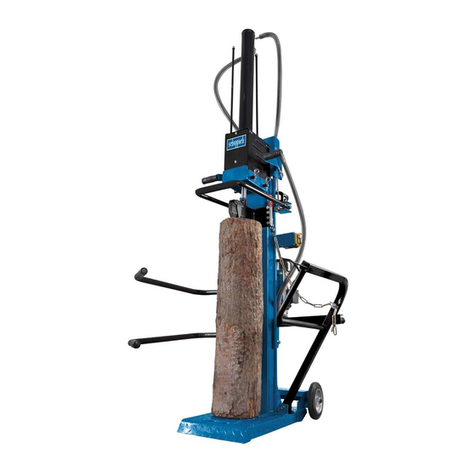
Scheppach
Scheppach HL1020 Translation of original instruction manual
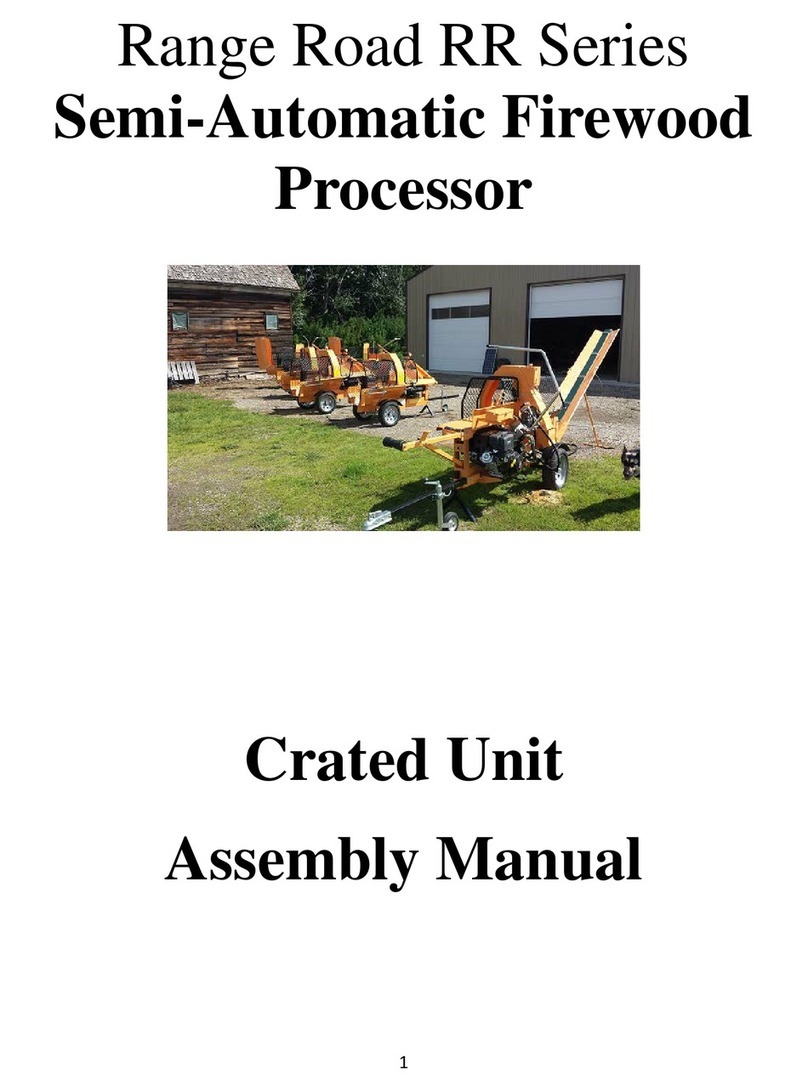
Range Road
Range Road rr series Assembly manual
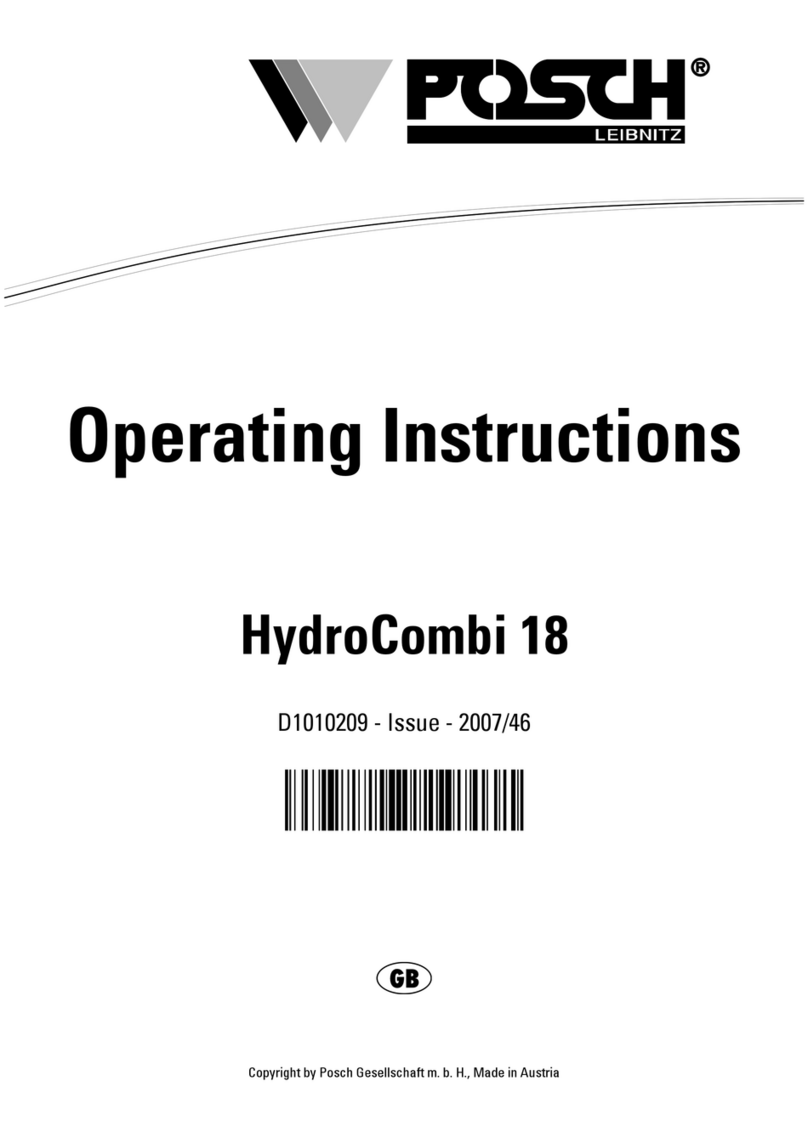
Posch
Posch HydroCombi 18 - PS operating instructions
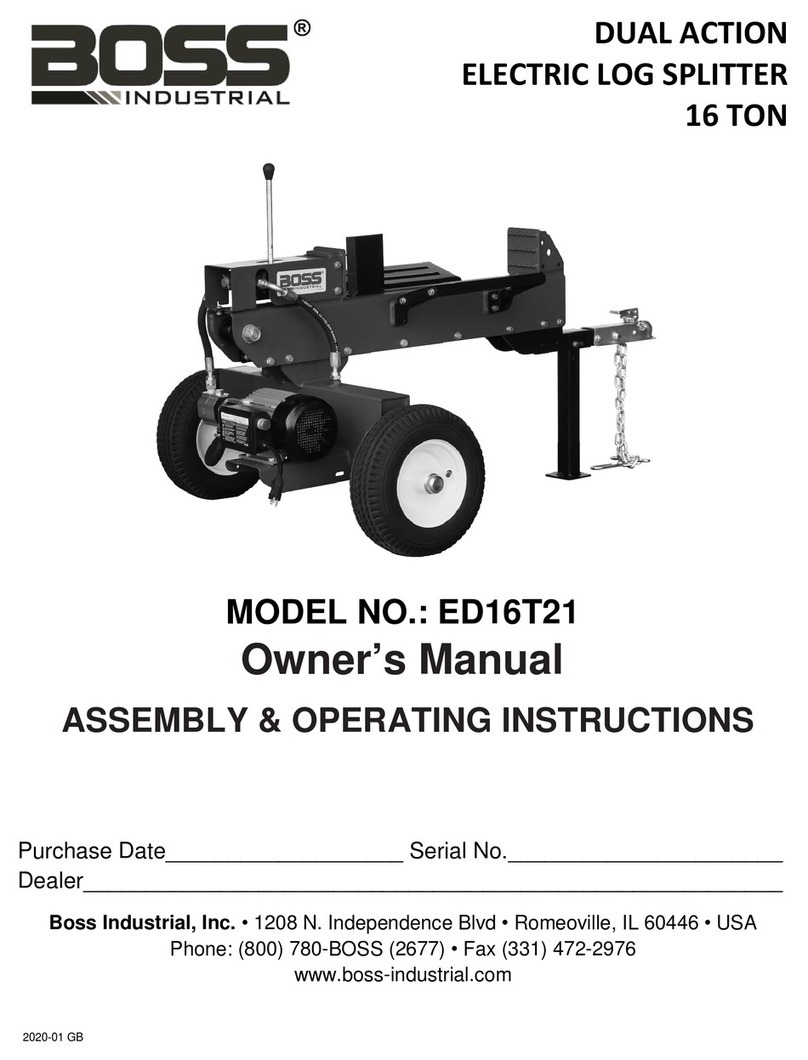
Boss Industrial
Boss Industrial ED16T21 Owners manual assembly & operating instructions
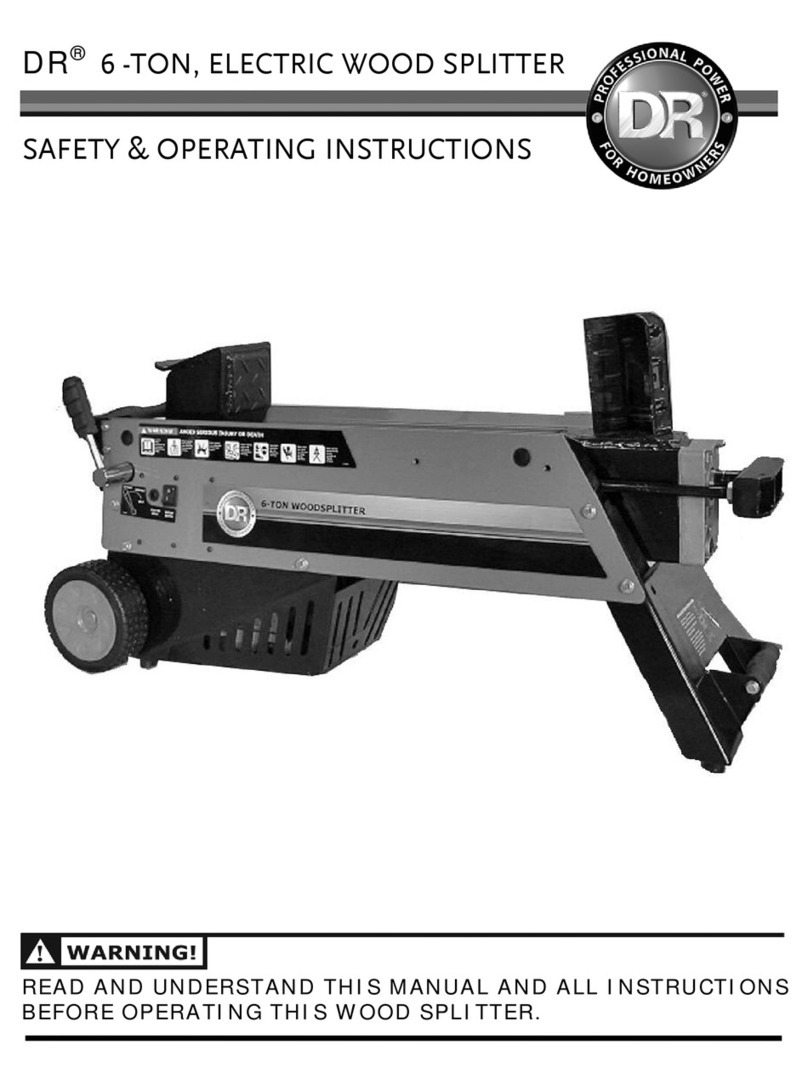
DR
DR 6-TON ELECTRIC WOOD SPLITTER Safety & Operating Instructions

Bell
Bell TURBO 8 E Manual for use and maintenance
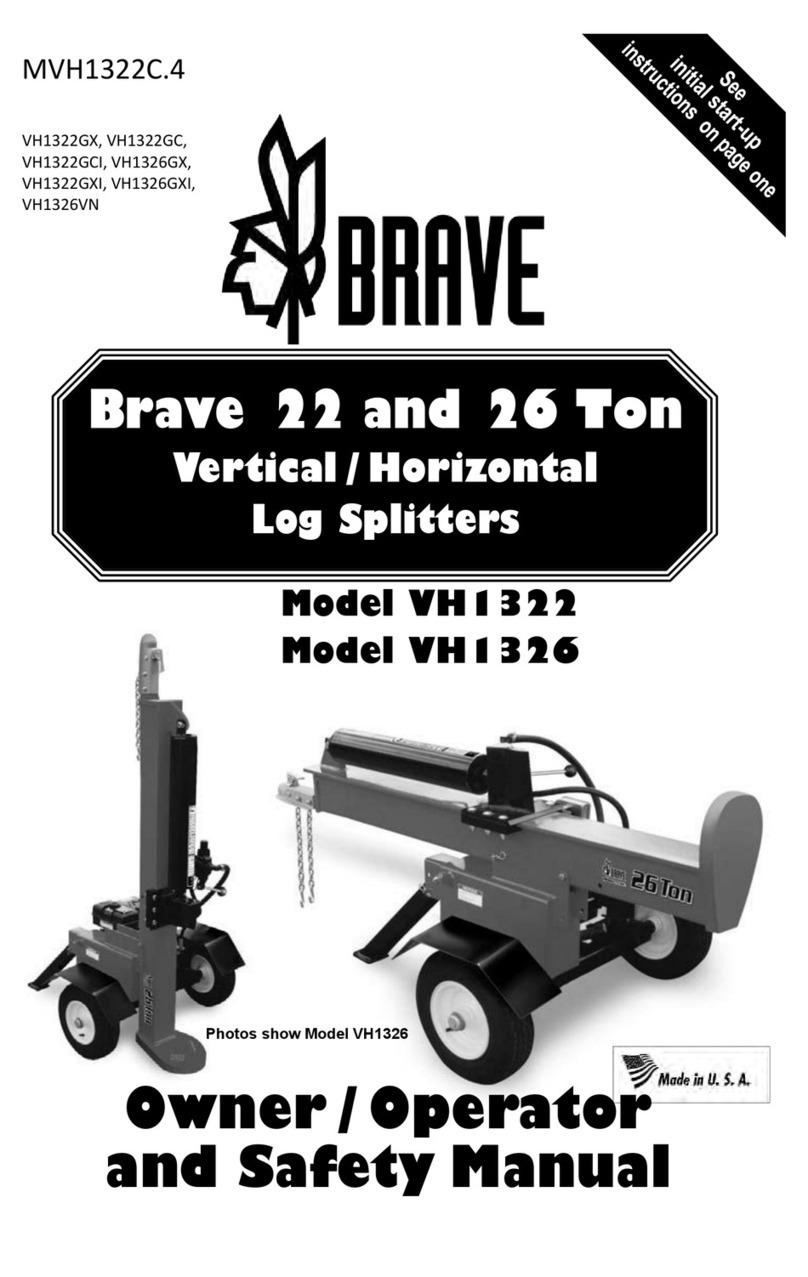
Brave
Brave VH1322GX Owner/operator and safety manual
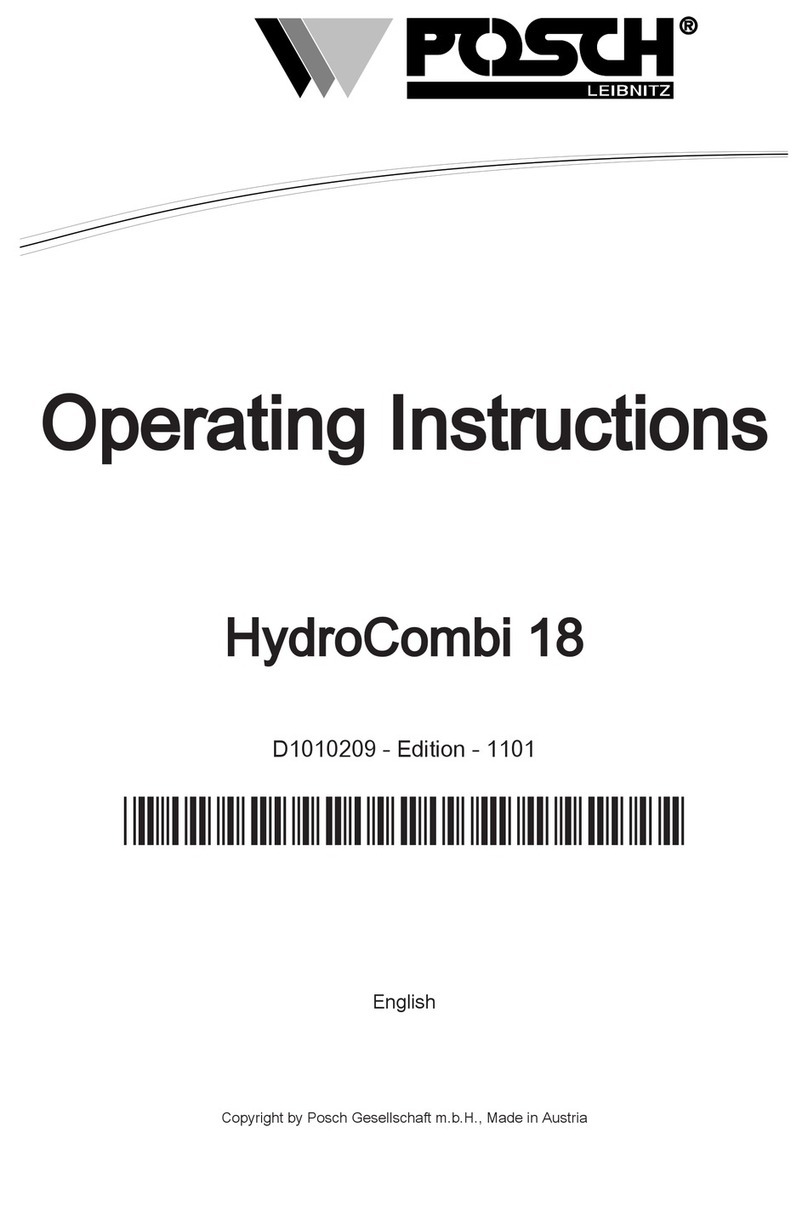
Posch
Posch HydroCombi 18 operating instructions
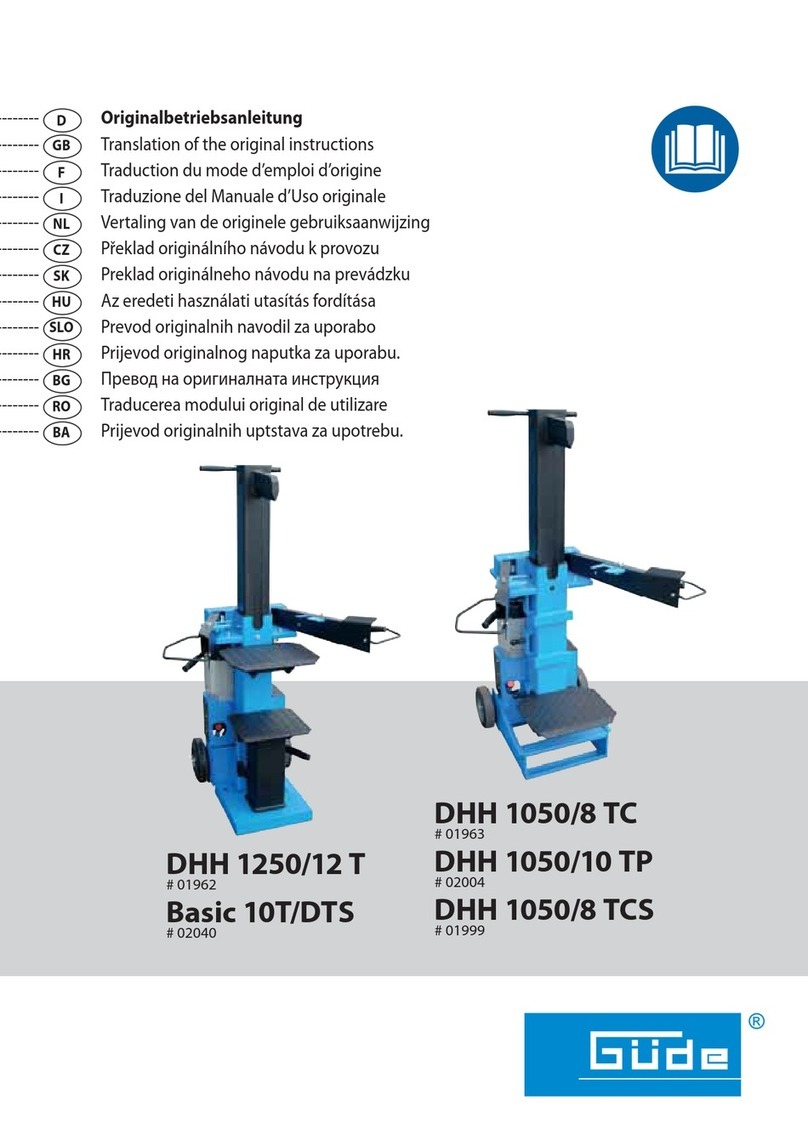
Gude
Gude DHH 1050/8 TCS Translation of the original instructions
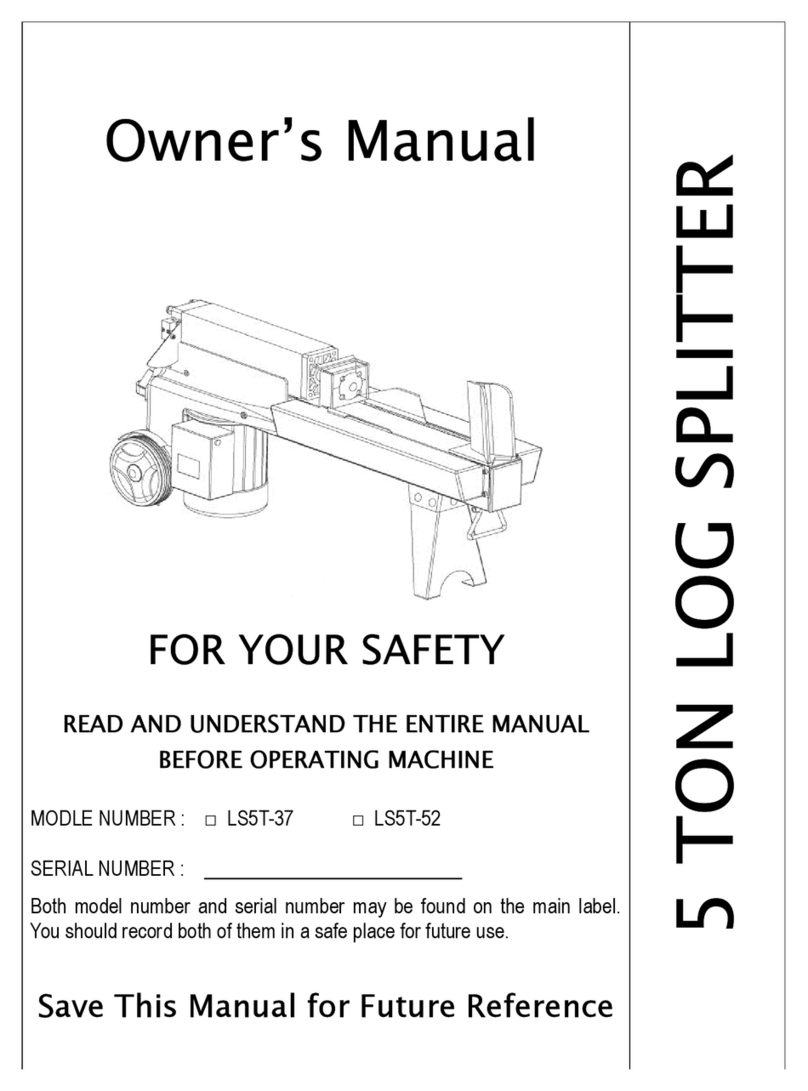
QCI
QCI LS5T-37 owner's manual
